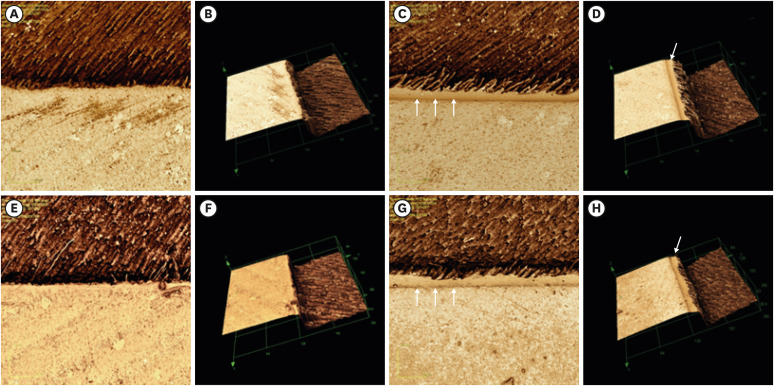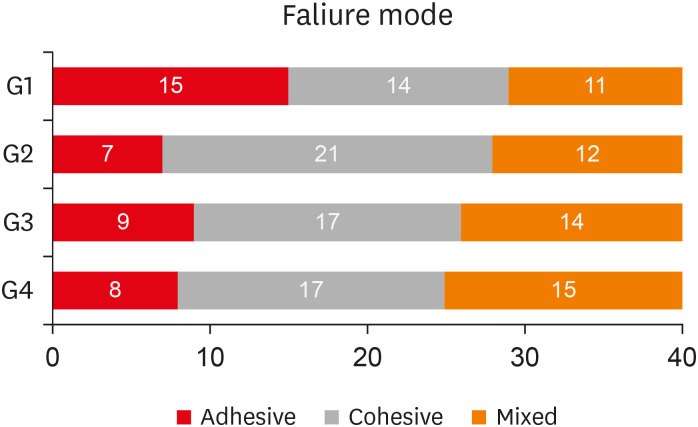Restor Dent Endod.
2022 May;47(2):e21. 10.5395/rde.2022.47.e21.
Bonding effects of cleaning protocols and time-point of acid etching on dentin impregnated with endodontic sealer
- Affiliations
-
- 1Department of Restorative Dentistry, School of Dentistry, Araraquara, São Paulo State University – UNESP, Araraquara, SP, Brazil
- KMID: 2548125
- DOI: http://doi.org/10.5395/rde.2022.47.e21
Abstract
Objectives
This study aimed to investigate the bonding effects of cleaning protocols on dentin impregnated with endodontic sealer residues using ethanol (E) or xylol (X). The effects of dentin acid etching immediately (I) or 7 days (P) after cleaning were also evaluated. For bonding to dentin, universal adhesive (Scotchbond Universal; 3M ESPE) was used. The persistence of sealer residues, hybrid layer formation and microshear bond strength were the performed analysis.
Materials and Methods
One hundred and twenty bovine dentin specimens were allocated into 4 groups (n = 10): G1 (E+I); G2 (X+I); G3 (E+P); and G4 (X+P). The persistence of sealer residues was evaluated by SEM. Confocal laser scanning microscopy images were taken to measure the formed hybrid layer using the Image J program. For microshear bond strength, 4 resin composite cylinders were placed over the dentin after the cleaning protocols. ANOVA followed by Tukey test and Kruskal-Wallis followed by Dunn test were used for parametric and non-parametric data, respectively (α = 5%).
Results
G2 and G4 groups showed a lower persistence of residues (p < 0.05) and thicker hybrid layer than the other groups (p < 0.05). No bond strength differences among all groups were observed (p > 0.05).
Conclusions
Dentin cleaning using xylol, regardless of the time-point of acid etching, provided lower persistence of residues over the surface and thicker hybrid layer. However, the bond strength of the universal adhesive system in etch-and-rinse strategy was not influenced by the cleaning protocols or time-point of acid etching.
Figure
Reference
-
1. Roberts S, Kim JR, Gu LS, Kim YK, Mitchell QM, Pashley DH, Tay FR. The efficacy of different sealer removal protocols on bonding of self-etching adhesives to AH plus-contaminated dentin. J Endod. 2009; 35:563–567. PMID: 19345806.
Article2. Bandeca MC, Kuga MC, Diniz AC, Jordão-Basso KC, Tonetto MR. Effects of the residues from the endodontic sealers on the longevity of esthetic restorations. J Contemp Dent Pract. 2016; 17:615–617. PMID: 27659075.
Article3. Bakaus TE, Gruber YL, Reis A, Gomes JC, Gomes GM. Bonding properties of universal adhesives to root canals prepared with different rotary instruments. J Prosthet Dent. 2019; 121:298–305. PMID: 30017154.
Article4. Kuga MC, Faria G, Rossi MA, do Carmo Monteiro JC, Bonetti-Filho I, Berbert FL, Keine KC, Só MV. Persistence of epoxy-based sealer residues in dentin treated with different chemical removal protocols. Scanning. 2013; 35:17–21. PMID: 22700418.
Article5. Mushtaq M, Masoodi A, Farooq R, Yaqoob Khan F. The dissolving ability of different organic solvents on three different root canal sealers: in vitro study. Iran Endod J. 2012; 7:198–202. PMID: 23130079.6. Korasli D, Ziraman F, Ozyurt P, Cehreli SB. Microleakage of self-etch primer/adhesives in endodontically treated teeth. J Am Dent Assoc. 2007; 138:634–640. PMID: 17473042.
Article7. Demırbuga S, Pala K, Topçuoğlu HS, Çayabatmaz M, Topçuoğlu G, Uçar EN. Effect of different gutta-percha solvents on the microtensile bond strength of various adhesive systems to pulp chamber dentin. Clin Oral Investig. 2017; 21:627–633.
Article8. Kaczor K, Krasowski M, Lipa S, Sokołowski J, Nowicka A. How do the etching mode and thermomechanical loading influence the marginal integrity of universal adhesives? Oper Dent. 2020; 45:306–317. PMID: 31750802.
Article9. Leite MLAES, Costa CAS, Duarte RM, Andrade AKM, Soares DG. Bond strength and cytotoxicity of a universal adhesive according to the hybridization strategies to dentin. Braz Dent J. 2018; 29:68–75. PMID: 29267527.
Article10. Muñoz MA, Luque I, Hass V, Reis A, Loguercio AD, Bombarda NH. Immediate bonding properties of universal adhesives to dentine. J Dent. 2013; 41:404–411. PMID: 23499568.
Article11. Oliveira SS, Pugach MK, Hilton JF, Watanabe LG, Marshall SJ, Marshall GW Jr. The influence of the dentin smear layer on adhesion: a self-etching primer vs. a total-etch system. Dent Mater. 2003; 19:758–767. PMID: 14511734.
Article12. Jordão-Basso KC, Kuga MC, Bandéca MC, Duarte MA, Guiotti FA. Effect of the time-point of acid etching on the persistence of sealer residues after using different dental cleaning protocols. Braz Oral Res. 2016; 30:e133. PMID: 28001242.
Article13. Langer A, Ilie N. Dentin infiltration ability of different classes of adhesive systems. Clin Oral Investig. 2013; 17:205–216.
Article14. Hass V, Cardenas A, Siqueira F, Pacheco RR, Zago P, Silva DO, Bandeca MC, Loguercio AD. Bonding performance of universal adhesive systems applied in etch-and-rinse and self-etch strategies on natural dentin caries. Oper Dent. 2019; 44:510–520. PMID: 31461392.
Article15. Wagner A, Wendler M, Petschelt A, Belli R, Lohbauer U. Bonding performance of universal adhesives in different etching modes. J Dent. 2014; 42:800–807. PMID: 24814138.
Article16. Rosa WL, Piva E, Silva AF. Bond strength of universal adhesives: a systematic review and meta-analysis. J Dent. 2015; 43:765–776. PMID: 25882585.
Article17. Morais JMP, Victorino KR, Escalante-Otárola WG, Jordão-Basso KCF, Palma-Dibb RG, Kuga MC. Effect of the calcium silicate-based sealer removal protocols and time-point of acid etching on the dentin adhesive interface. Microsc Res Tech. 2018; 81:914–920. PMID: 29904966.
Article18. Kuga MC, Só MV, De Faria-júnior NB, Keine KC, Faria G, Fabricio S, Matsumoto MA. Persistence of resinous cement residues in dentin treated with different chemical removal protocols. Microsc Res Tech. 2012; 75:982–985. PMID: 22419602.
Article19. Martos J, Bassotto AP, González-Rodríguez MP, Ferrer-Luque CM. Dissolving efficacy of eucalyptus and orange oil, xylol and chloroform solvents on different root canal sealers. Int Endod J. 2011; 44:1024–1028. PMID: 21658077.
Article20. Shenoi PR, Badole GP, Khode RT. Evaluation of softening ability of Xylene & Endosolv-R on three different epoxy resin based sealers within 1 to 2 minutes - an in vitro study. Restor Dent Endod. 2014; 39:17–23. PMID: 24516825.
Article21. Kuga MC, Só MV, De Campos EA, Faria G, Keine KC, Dantas AA, Faria NB Jr. Persistence of endodontic methacrylate-based cement residues on dentin adhesive surface treated with different chemical removal protocols. Microsc Res Tech. 2012; 75:1432–1436. PMID: 22718396.
Article22. Guzmán-Armstrong S, Armstrong SR, Qian F. Relationship between nanoleakage and microtensile bond strength at the resin-dentin interface. Oper Dent. 2003; 28:60–66. PMID: 12540120.23. Cardoso MV, de Almeida Neves A, Mine A, Coutinho E, Van Landuyt K, De Munck J, Van Meerbeek B. Current aspects on bonding effectiveness and stability in adhesive dentistry. Aust Dent J. 2011; 56(Supplement 1):31–44. PMID: 21564114.
Article24. Pane ES, Palamara JE, Messer HH. Critical evaluation of the push-out test for root canal filling materials. J Endod. 2013; 39:669–673. PMID: 23611388.
Article25. Yoshiyama M, Urayama A, Kimochi T, Matsuo T, Pashley DH. Comparison of conventional vs self-etching adhesive bonds to caries-affected dentin. Oper Dent. 2000; 25:163–169. PMID: 11203811.26. Hanabusa M, Mine A, Kuboki T, Momoi Y, Van Ende A, Van Meerbeek B, De Munck J. Bonding effectiveness of a new ‘multi-mode’ adhesive to enamel and dentine. J Dent. 2012; 40:475–484. PMID: 22381614.
Article27. Perdigão J, Sezinando A, Monteiro PC. Laboratory bonding ability of a multi-purpose dentin adhesive. Am J Dent. 2012; 25:153–158. PMID: 22988685.28. Perdigão J, Kose C, Mena-Serrano AP, De Paula EA, Tay LY, Reis A, Loguercio AD. A new universal simplified adhesive: 18-month clinical evaluation. Oper Dent. 2014; 39:113–127. PMID: 23802645.
Article29. Chen C, Niu LN, Xie H, Zhang ZY, Zhou LQ, Jiao K, Chen JH, Pashley DH, Tay FR. Bonding of universal adhesives to dentine--old wine in new bottles? J Dent. 2015; 43:525–536. PMID: 25797702.30. Heintze SD, Rousson V, Mahn E. Bond strength tests of dental adhesive systems and their correlation with clinical results - a meta-analysis. Dent Mater. 2015; 31:423–434. PMID: 25711699.
Article31. Hirokane E, Takamizawa T, Kasahara Y, Ishii R, Tsujimoto A, Barkmeier WW, Latta MA, Miyazaki M. Effect of double-layer application on the early enamel bond strength of universal adhesives. Clin Oral Investig. 2021; 25:907–921.32. Fujiwara S, Takamizawa T, Barkmeier WW, Tsujimoto A, Imai A, Watanabe H, Erickson RL, Latta MA, Nakatsuka T, Miyazaki M. Effect of double-layer application on bond quality of adhesive systems. J Mech Behav Biomed Mater. 2018; 77:501–509. PMID: 29040961.
- Full Text Links
- Actions
-
Cited
- CITED
-
- Close
- Share
- Similar articles
-
- Effect of additional etching and ethanol-wet bonding on the dentin bond strength of one-step self-etch adhesives
- The bonding durability of total etching adhesives on dentin
- The effect of bonding resin on bond strength of dual-cure resin cements
- The influence of AH-26 and zinc oxide-eugenol root canal sealer on the shear bond strength of composite resin to dentin
- THE EFFECTS OF SURFACE TREATMENT AND THERMOCYCLING ON THE MICROLEAKAGE OF COMPOSITE RESIN CORES




